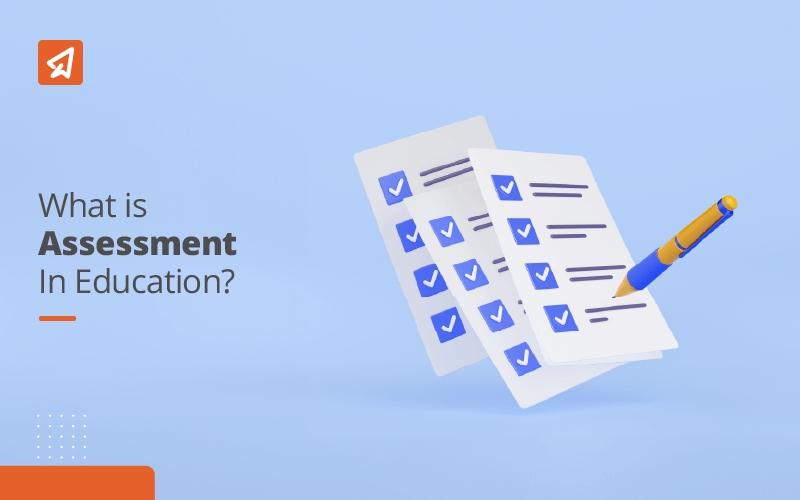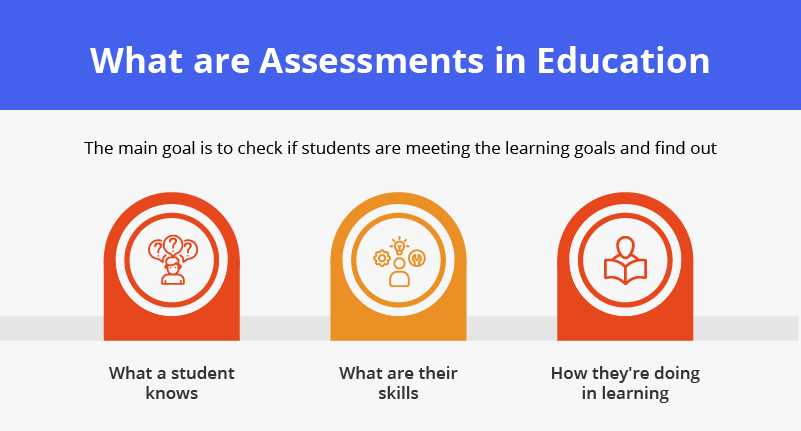Assessment in Education – Its Types & Purpose

Checking how students are doing in school is essential, but it can get confusing with all the different types of assessments. There’s assessment for learning, assessment as learning, and assessment of learning. Plus, every school community seems to have its own way of monitoring student progress. The importance of assessment in education cannot be overstated, as it plays a crucial role in guiding both teaching and learning processes.
So, what are the basic types of assessment, and how do you use them in teaching? We looked at the common ones in early education to give you a starting point or just a quick review! Without waiting further, let’s dive in.
What Are Assessments in Education?

In education, assessments mean collecting information about what a student knows, their skills, and how they’re doing in learning. The main goal is to check if students are meeting the learning goals and to guide how teaching and learning happen. Assessments take various forms and serve multiple functions within the educational context. Here, we’ll break down some important types of assessments.
Traditionally, classroom assessments have relied on methods like quizzes, tests, and essays. These assessments provide valuable snapshots of student learning, but may not always capture the full picture.
In the evolving landscape of education, smart classrooms are emerging with new assessment possibilities. These classrooms may utilize interactive whiteboards, educational software, and online platforms to deliver assessments. This allows for more dynamic and personalized assessments, such as adaptive quizzes that adjust difficulty based on student performance, or gamified learning experiences that incorporate formative assessment throughout the learning process.
What Are the Types of Assessments in Education?
1. Diagnostic Assessments
At the beginning of the school year, or even before starting a new unit or lesson, you can do a diagnostic assessment to figure out what your students already know and what they might be struggling with. This kind of early check helps identify learning gaps and gives you a sense of where each student stands.
The cool thing about diagnostic assessments is that they’re not about grades but more for teachers to understand what they need to cover. You can do them in a chill way, like through student surveys or chats, or in a more official style, like a curriculum-based test.
These assessments are vital for spotting what your students are good at so you can build on that and figure out where they might need extra help. They also:
- Give you a starting point for future assessments. Make teaching more efficient.
- Help you personalise how you teach.
- Connect what students are learning to specific goals.
Some examples include:
- Short quizzes
- Journal entries
- Student interviews
- Student reflections
- Classroom discussions
- Graphic organisers (e.g., mind maps, flow charts, KWL charts)
2. Formative Assessments
Formative assessment happens while you’re in the middle of teaching. It’s like having a little spy in the room, picking up on what students are getting and what they’re not quite getting while you’re upfront doing your thing.
These assessments are relaxed and don’t add stress for students. You can incorporate simple methods like asking a few questions on a sticky note or having them complete a brief exit ticket. The objective is to use this real-time information to adjust your teaching on the spot, whether it involves individual students or the entire class.
Just like the diagnostic assessment, formative assessment helps teachers find where students might be struggling and adjust their teaching methods to assist them. The benefits of formative assessment include:
- You get feedback on your teaching right away.
- It helps you personalise your teaching.
- You can give specific feedback.
- More students get involved.
- Even those who don’t rock formal tests can feel a sense of accomplishment.
- It’s like a sneak peek into what’s going on in your students’ heads.
Some examples include:
- Portfolios
- Group projects
- Progress reports
- Class discussions
- Entry and exit tickets
- Short, regular quizzes
3. Summative Assessments
Summative assessments are usually done to give a final grade and happen at the end of something, like a semester, school year, or a unit.
Examples of summative assessments include end-of-lesson quizzes, projects or portfolios, and district or state tests. But the main goal is the same: to see how much a student has learned based on certain standards. Summative assessments show a teacher what knowledge and skills a student has picked up, helping identify strengths and weaknesses, just like other assessments.
Summative assessments have some advantages:
- They show what students have learned.
- They help you know if students are ready for what’s next, whether it’s a lesson, a unit, or even the next school year.
- They let students put what they’ve learned into action.
- They pinpoint areas where both teaching and learning might need more attention.
Also read: Formative Assessment vs Summative Assessment
4. Ipsative Assessments
An ipsative assessment in education helps figure out a student’s personal strengths, weaknesses, and growth.
The word “ipsative” is from Latin, where “ipse” means “of the self.” In education, it means “comparing how a person is doing now to how they did before.” This kind of assessment is a real way to see how a student is progressing because it’s all about that individual student. It’s way different from those standardised tests that compare students to a “norm.”
You can make ipsative assessments using other assessments. For example, you might check how a student did on a pre-test at the start and compare it to their results on a post-test later for a clear measurement of progress. Some examples of this assessment include:
- Portfolios
- A two-stage testing process
- Project-based learning activities
5. Norm-referenced Assessments
Norm-referenced assessments are basically tests that compare you to other people your age or in your group. They look at national standards and sometimes adjust for things like age or ethnicity.
Unlike tests where you’re only trying to beat your own score, norm-referenced assessments use a bunch of data from different people to figure out how well you’re doing.
Examples of these tests are IQ tests, physical assessments, and big college entry tests like the SAT and GRE.
Assessment Centre by Extramarks
Teacher’s Time, Optimized: The Assessment Centre by Extramarks unleashes AI for Smarter Testing. Create, Grade, and Shine!
Learn More6. Criterion-referenced Assessments
Criterion-referenced assessments compare how well a student does against a specific learning standard, no matter what other students are doing. In class, it means checking how a student is doing compared to the set grade-level standards, maybe through end-of-unit or final tests.
Outside of class, you see criterion-referenced assessments in things like professional licensing exams or citizenship tests. Here, students need to get a certain percentage of questions right to pass.
These assessments are often looked at next to norm-referenced assessments. Both types check what students have learned, but criterion-referenced ones don’t compare students to each other. They look at each student individually, showing what they’re good at and where they can improve. Some examples of criterion-referenced assessments include:
- Rubrics
- Checklists
- Concept Mapping
7. Scenario-based Assessments
Scenario-based assessment is all about using interactive scenarios to help students learn actively. It sets up a made-up situation where students use what they’ve learned in theory.
This kind of assessment lets students go beyond just reading a textbook or listening to a lecture. They get to apply what they know in real-world situations. For teachers, it’s a great way to really see if students understand the subject. You can watch how they use what they’ve learned in actual situations.
Examples:
- Role-Playing Exercises
- Problem-Based Learning
- Debates and Discussions
8. Confirmative Assessments
Once you’ve put your teaching plan into action, it’s important to check in with assessments. Confirmative assessments help you see if your teaching is still working even after some time, like a year later. It’s like a bigger version of a summative assessment, giving you a good look at how well your teaching methods are holding up.
Example includes:
- Follow-Up Surveys
9. Oral Assessments
When teachers ask questions or give short tasks, oral assessments use conversations to figure out what students know and can do. It gives a better view of their skills, how they think, and where they might be confused. Plus, it helps build a closer bond between teachers and students.
Oral assessments can be things like:
- Talking about a topic you got ready for (alone or with a group, live or recorded)
- Chats or discussions
- Acting out real-life situations
Examples:
- Presentations on a prepared topic (individual or group, live or recorded)
- Interviews or discussions
- Simulations
10. Gamified Assessments
Gamified assessments are like a fancy upgrade to regular tests. They mix game elements into aptitude and personality exams, making them quick and fun. But don’t be fooled by the playfulness—they’re still based on science and stats.
These assessments are not only enjoyable but also encourage more people to take part. Plus, they help analyse important skills and behaviours through things like short skill tests, longer games for personality checks, and even job simulation experiences and trivia quizzes.
Some notable examples include:
- Board Games
- Scavenger Hunts
- Trivia Competitions
Also Read: Gamification in Education
11. Skill Assessments
A skill assessment is basically a test to check how good a student is at a particular skill or group of skills. During the test, students have to show what they know about a certain topic, subject, or problem. The idea is to compare what they know with what’s expected based on the standards for that subject. The goal is to figure out if students have the skills the curriculum expects them to have.
Assessment Centre by Extramarks
Master the Art of Effortless Evaluation and Assessments Transform your testing with Extramarks’ Assessment Centre.
Learn More12. Interim Assessments
An interim assessment, as the name suggests, checks how a student is doing midway through a course. It’s mainly to see if the student is gearing up for the final exam. Think of interim assessment as something between a check-in during the course (formative assessment) and the big final test (summative assessment).
This type of assessment works well for:
- Mid-term exams in school or college
- Tests on specific chapters or projects during the term
It’s a handy way to keep an eye on how students are doing and fix things if needed.
When creating an interim assessment:
- Stick to topics you’ve already covered in the course
- Keep it shorter than the final exam
- Remember, the goal is to track progress and get students ready for the big final.
13. Alternative Assessments
Alternative assessment is a way of figuring out what students know by looking at how they apply their new knowledge to real tasks. It’s a more personalised approach, where the instructor tailors the evaluation to each student’s needs and abilities.
Instead of relying on standardised tests, students dive into hands-on tasks that make them use what they’ve learned. This type of assessment gives the teacher a better understanding of how well a student grasps a subject.
To make alternative assessments work best, it’s important to match your methods with the overall goals of the training or subject. This could involve tasks like creating concept maps, writing reports, or teaming up for collaborative testing.
Summarising the Purpose of Assessments in Education
- Diagnostic Assessment: This one’s about spotting where your students shine and where they might need a boost before you kick off your teaching. It’s like a sneak peek to help you customise your lessons to fit each student.
- Formative Assessment: Keeping a pulse on how your students are doing as you teach. It’s your real-time guide to adjusting your methods and helping your students track their progress.
- Summative Assessment: When it’s time to wrap things up, this assessment evaluates how well your students have grasped everything. It’s the grades and the overall summary of subject mastery.
- Ipsative Assessments: This is about tracking an individual student’s progress by comparing their current performance to their past efforts. It’s all about personal growth, not how they measure up to others.
- Norm-Referenced Assessments: Here, you’re comparing a student’s performance to a group to see where they stand. It’s about rankings and categories.
- Criterion-Referenced Assessments: You’re checking if a student has nailed specific learning goals. Their performance is measured against set standards, not against their classmates.
- Scenario-Based Assessment: Putting your students to the test in real-world situations. It’s all about problem-solving and critical thinking.
- Confirmative Assessment: This is the verification step. It’s about making sure your learning goals are met and your students acquire the necessary knowledge and skills. Typically, this happens at the end of a teaching unit.
- Oral Assessment: Evaluating your students’ spoken language skills, from communication to pronunciation. It’s a window into both their linguistic and cognitive abilities.
- Gamified Assessment: Turning assessments into a bit of a game. It’s all about making assessments enjoyable, motivating, and effective by adding in elements of competition, challenge, and rewards.
- Skill Assessment: Measuring your students’ specific practical abilities in areas like communication or problem-solving. It’s about assessing their real-world skills.
Closing Thoughts
Alright, that’s the scoop on assessments in school! Whether it’s a quick check or a big test, assessments help teachers see how we’re doing. It’s not just about grades – it’s about learning and getting better. So, as we use these assessments, let’s keep things fun, helpful, and all about growing smarter. Here’s to learning and growing together in the awesome world of education!
Boost Your Students’ Performance with Cutting-Edge Assessments
Unlock a world of personalised learning and academic excellence with the help of the Extramarks Assessment Centre.
Learn MoreLast Updated on August 9, 2024










